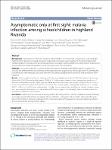Asymptomatic only at first sight: malaria infection among schoolchildren in highland Rwanda
Sifft, Kevin C.
Geus, Dominik
Mukampunga, Caritas
Mugisha, Jean Claude
Habarugira, Felix
Fraundorfer, Kira
Bayingana, Claude
Ndoli, Jules
Umulisa, Irenee
Karema, Corine
Samson-Himmelstjerna, George von
Aebischer, Toni
Martus, Peter
Sendegeya, Augustin
Gahutu, Jean Bosco
Mockenhaupt, Frank P.
Background: Plasmodium infection and malaria in school children are increasingly recognized as a relevant public health problem, but data on actual prevalence and health consequences are insufficient. The present study from highland southern Rwanda aimed at estimating infection prevalence among children attending school, at identifying associated factors and at assessing the clinical consequences of these infections. Methods: In a survey including 12 schools in the Huye district of Rwanda, 1089 children aged 6–10 years were clinically and anthropometrically examined, malaria parasites were diagnosed by microscopy and PCR, haemoglobin concentrations were measured, and socio-economic and behavioural parameters as well as medical histories were obtained. Results: Upon examination, the vast majority of children was asymptomatic (fever 2.7%). Plasmodium infection was detected in 22.4% (Plasmodium falciparum, 18.8%); 41% of these were submicroscopic. Independent predictors of infection included low altitude, higher age, preceding antimalarial treatment, and absence of electricity or a bicycle in the household. Plasmodium infection was associated with anaemia (mean haemoglobin difference of −1.2 g/dL; 95% CI, −0.8 to −1.5 g/dL), fever, underweight, clinically assessed malnutrition and histories of fever, tiredness, weakness, poor appetite, abdominal pain, and vomiting. With the exception of underweight, these conditions were also increased at submicroscopic infection. Conclusion: Malaria infection is frequent among children attending school in southern highland Rwanda. Although seemingly asymptomatic in the vast majority of cases, infection is associated with a number of non-specific symptoms in the children´s histories, in addition to the impact on anaemia. This argues for improved malaria surveillance and control activities among school children.
No license information

